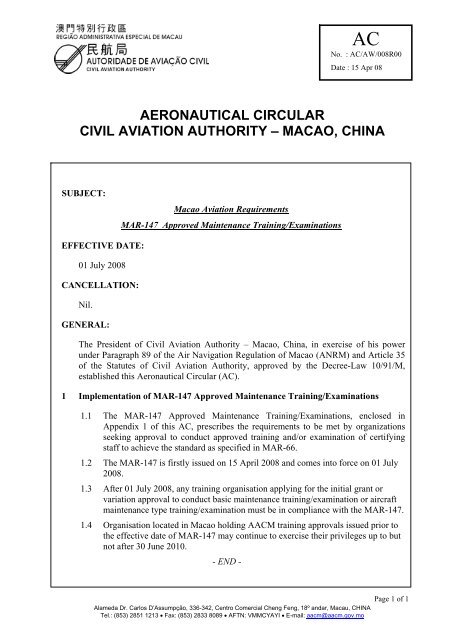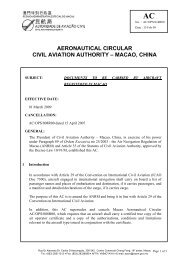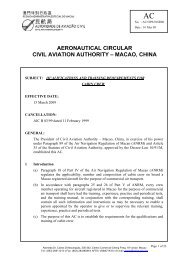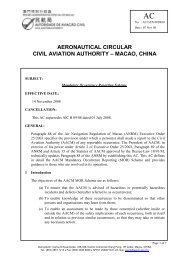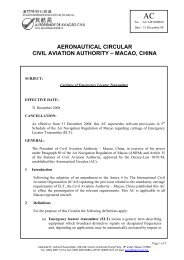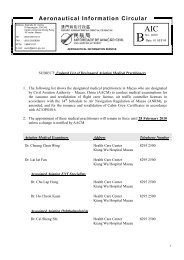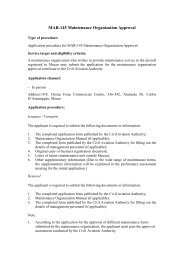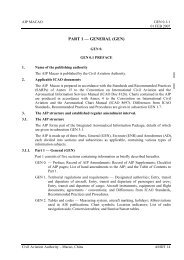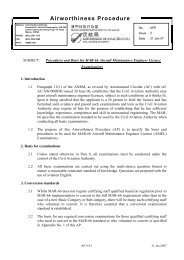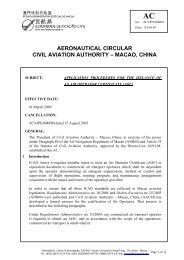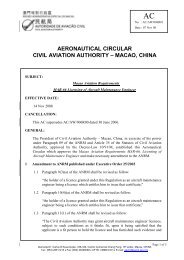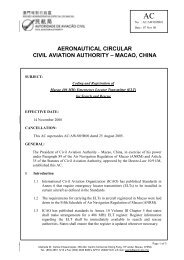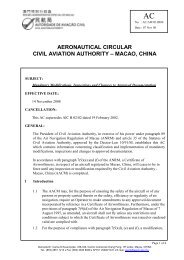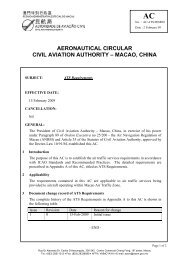Macao Aviation Requirements MAR-147 Approved Maintenance ...
Macao Aviation Requirements MAR-147 Approved Maintenance ...
Macao Aviation Requirements MAR-147 Approved Maintenance ...
You also want an ePaper? Increase the reach of your titles
YUMPU automatically turns print PDFs into web optimized ePapers that Google loves.
AC<br />
No. : AC/AW/008R00<br />
Date : 15 Apr 08<br />
AERONAUTICAL CIRCULAR<br />
CIVIL AVIATION AUTHORITY – MACAO, CHINA<br />
SUBJECT:<br />
<strong>Macao</strong> <strong>Aviation</strong> <strong>Requirements</strong><br />
<strong>MAR</strong>-<strong>147</strong> <strong>Approved</strong> <strong>Maintenance</strong> Training/Examinations<br />
EFFECTIVE DATE:<br />
01 July 2008<br />
CANCELLATION:<br />
Nil.<br />
GENERAL:<br />
The President of Civil <strong>Aviation</strong> Authority – <strong>Macao</strong>, China, in exercise of his power<br />
under Paragraph 89 of the Air Navigation Regulation of <strong>Macao</strong> (ANRM) and Article 35<br />
of the Statutes of Civil <strong>Aviation</strong> Authority, approved by the Decree-Law 10/91/M,<br />
established this Aeronautical Circular (AC).<br />
1 Implementation of <strong>MAR</strong>-<strong>147</strong> <strong>Approved</strong> <strong>Maintenance</strong> Training/Examinations<br />
1.1 The <strong>MAR</strong>-<strong>147</strong> <strong>Approved</strong> <strong>Maintenance</strong> Training/Examinations, enclosed in<br />
Appendix 1 of this AC, prescribes the requirements to be met by organizations<br />
seeking approval to conduct approved training and/or examination of certifying<br />
staff to achieve the standard as specified in <strong>MAR</strong>-66.<br />
1.2 The <strong>MAR</strong>-<strong>147</strong> is firstly issued on 15 April 2008 and comes into force on 01 July<br />
2008.<br />
1.3 After 01 July 2008, any training organisation applying for the initial grant or<br />
variation approval to conduct basic maintenance training/examination or aircraft<br />
maintenance type training/examination must be in compliance with the <strong>MAR</strong>-<strong>147</strong>.<br />
1.4 Organisation located in <strong>Macao</strong> holding AACM training approvals issued prior to<br />
the effective date of <strong>MAR</strong>-<strong>147</strong> may continue to exercise their privileges up to but<br />
not after 30 June 2010.<br />
- END -<br />
Alameda Dr. Carlos D’Assumpção, 336-342, Centro Comercial Cheng Feng, 18º andar, Macau, CHINA<br />
Tel.: (853) 2851 1213 • Fax: (853) 2833 8089 • AFTN: VMMCYAYI • E-mail: aacm@aacm.gov.mo<br />
Page 1 of 1
Appendix 1<br />
AC<br />
No. : AC/AW/008R00<br />
Date : 15 Apr 08<br />
Alameda Dr. Carlos D’Assumpção, 336-342, Centro Comercial Cheng Feng, 18º andar, Macau, CHINA<br />
Tel.: (853) 2851 1213 • Fax: (853) 2833 8089 • AFTN: VMMCYAYI • E-mail: aacm@aacm.gov.mo
<strong>MAR</strong>‐<strong>147</strong><br />
Application for further copies of the <strong>Macao</strong> <strong>Aviation</strong> <strong>Requirements</strong> should be addressed<br />
to:<br />
Civil <strong>Aviation</strong> Authority<br />
Alameda Dr. Carlos D’Assumpção, 336-342<br />
Centro Comercial Cheng Feng, 18º andar<br />
Macau<br />
CHINA<br />
FAX : (853) 2833 8089<br />
TEL : (853) 2851 1213<br />
E-MAIL<br />
: aacm@aacm.gov.mo<br />
ISSUE 1 0-2 15/Apr/2008
<strong>MAR</strong>‐<strong>147</strong><br />
TABLE OF CONTENT<br />
LIST OF EFFECTIVE PAGES ......................................................................................................... 0-5<br />
FOREWORD ....................................................................................................................................... 0-6<br />
PREAMBLES ...................................................................................................................................... 0-7<br />
SECTION 1. REQUIREMENTS .................................................................................................. 1-1<br />
<strong>MAR</strong> <strong>147</strong>.1 General ................................................................................................................. 1-1<br />
<strong>MAR</strong> <strong>147</strong>.10 Definitions ............................................................................................................ 1-2<br />
<strong>MAR</strong> <strong>147</strong>.15 Applicability ......................................................................................................... 1-3<br />
<strong>MAR</strong> <strong>147</strong>.20 Application and issue ........................................................................................... 1-3<br />
<strong>MAR</strong> <strong>147</strong>.25 Extent of approval ................................................................................................ 1-3<br />
<strong>MAR</strong> <strong>147</strong>.30 Facility requirements ............................................................................................ 1-3<br />
<strong>MAR</strong> <strong>147</strong>.35 Personnel requirements ........................................................................................ 1-4<br />
<strong>MAR</strong> <strong>147</strong>.40 Records of instructors, examiners and assessors .................................................. 1-5<br />
<strong>MAR</strong> <strong>147</strong>.45 Instructional equipment ........................................................................................ 1-5<br />
<strong>MAR</strong> <strong>147</strong>.50 <strong>Maintenance</strong> training material .............................................................................. 1-5<br />
<strong>MAR</strong> <strong>147</strong>.55 Records ................................................................................................................ 1-6<br />
<strong>MAR</strong> <strong>147</strong>.60 Training procedures and quality system ............................................................... 1-6<br />
<strong>MAR</strong> <strong>147</strong>.65 Training organisation exposition .......................................................................... 1-6<br />
<strong>MAR</strong> <strong>147</strong>.70 Privileges of the approved maintenance training organisation ............................. 1-7<br />
<strong>MAR</strong> <strong>147</strong>.75 Changes to the <strong>MAR</strong>–<strong>147</strong> approved maintenance training organisation ............. 1-8<br />
<strong>MAR</strong> <strong>147</strong>.80 Continued Validity of Approval ........................................................................... 1-8<br />
<strong>MAR</strong> <strong>147</strong>.85 The approved basic training course ...................................................................... 1-9<br />
<strong>MAR</strong> <strong>147</strong>.90 Examinations general ......................................................................................... 1-10<br />
<strong>MAR</strong> <strong>147</strong>.95 Basic knowledge examinations .......................................................................... 1-10<br />
<strong>MAR</strong> <strong>147</strong>.100 Basic practical assessment ................................................................................. 1-11<br />
<strong>MAR</strong> <strong>147</strong>.105 <strong>Approved</strong> aircraft type/task training .................................................................. 1-12<br />
<strong>MAR</strong> <strong>147</strong>.110 Aircraft type examinations ................................................................................. 1-12<br />
<strong>MAR</strong> <strong>147</strong>.115 Equivalent safety cases ...................................................................................... 1-13<br />
<strong>MAR</strong> <strong>147</strong>.120 Revocation, suspension, limitation, refusal to renew the <strong>MAR</strong>–<strong>147</strong> approval or<br />
acceptance 1-13<br />
SECTION 2. ACCEPTABLE MEANS OF COMPLIANCE AND<br />
INTERPRETATIVE/EXPLANATORY MATERIAL (AMC & IEM) .......................................... 2-1<br />
IEM <strong>147</strong>.1 General .................................................................................................................... 2-2<br />
IEM <strong>147</strong>.10 Definitions .......................................................................................................... 2-2<br />
IEM <strong>147</strong>.15(b) Applicability ......................................................................................................... 2-2<br />
AMC <strong>147</strong>.15(c) Applicability .................................................................................................... 2-2<br />
IEM <strong>147</strong>.15(c) Applicability ......................................................................................................... 2-3<br />
AMC <strong>147</strong>.30(b) Facilities <strong>Requirements</strong> ................................................................................... 2-3<br />
AMC <strong>147</strong>.30(d) and (e) Facilities <strong>Requirements</strong> ......................................................................... 2-3<br />
IEM <strong>147</strong>.30(h) Facilities <strong>Requirements</strong> ........................................................................................ 2-4<br />
IEM <strong>147</strong>.35(a) Personnel <strong>Requirements</strong> ....................................................................................... 2-4<br />
AMC <strong>147</strong>.35(a) Personnel <strong>Requirements</strong> .................................................................................. 2-4<br />
IEM <strong>147</strong>.35(b) Personnel <strong>Requirements</strong> ....................................................................................... 2-5<br />
AMC <strong>147</strong>.35(c) Personnel <strong>Requirements</strong> .................................................................................. 2-5<br />
AMC <strong>147</strong>.35(d) Personnel <strong>Requirements</strong> .................................................................................. 2-5<br />
AMC <strong>147</strong>.35(e) Personnel <strong>Requirements</strong> .................................................................................. 2-5<br />
IEM <strong>147</strong>.45(a) Instructional Equipment ....................................................................................... 2-6<br />
IEM <strong>147</strong>.45(c) Instructional Equipment ....................................................................................... 2-6<br />
AMC <strong>147</strong>.50(a) <strong>Maintenance</strong> Training Material ....................................................................... 2-6<br />
AMC <strong>147</strong>.60(b) Training Procedures and Quality System ........................................................ 2-6<br />
15/Apr/2008 0-3 ISSUE 1
<strong>MAR</strong>‐<strong>147</strong><br />
AMC <strong>147</strong>.70(d) Privileges of the approved maintenance training organisation ........................ 2-7<br />
IEM <strong>147</strong>.70(d) Privileges of the approved maintenance training organisation ............................. 2-8<br />
AMC <strong>147</strong>.85(d) <strong>Approved</strong> Basic Training Course .................................................................... 2-9<br />
AMC <strong>147</strong>.85(f) <strong>Approved</strong> Basic Training Course .................................................................... 2-9<br />
AMC <strong>147</strong>.85(g) <strong>Approved</strong> Basic Training Course .................................................................... 2-9<br />
AMC <strong>147</strong>.85(h) <strong>Approved</strong> Basic Training Course .................................................................... 2-9<br />
AMC <strong>147</strong>.85(i) <strong>Approved</strong> Basic Training Course .................................................................... 2-9<br />
AMC <strong>147</strong>.85(j) <strong>Approved</strong> Basic Training Course .................................................................... 2-9<br />
AMC <strong>147</strong>.85(k) <strong>Approved</strong> Basic Training Course .................................................................. 2-10<br />
AMC <strong>147</strong>.85(l) <strong>Approved</strong> Basic Training Course .................................................................. 2-10<br />
IEM <strong>147</strong>.85(f), (g), (h), (i), (j), (k) <strong>Approved</strong> Basic Training Course ......................................... 2-10<br />
AMC <strong>147</strong>.95(d) Basic Knowledge Examinations .................................................................... 2-10<br />
IEM <strong>147</strong>.95(f) Basic Knowledge Examinations ....................................................................... 2-10<br />
AMC <strong>147</strong>.100(b) Basic Practical Assessments .......................................................................... 2-11<br />
AMC <strong>147</strong>.105(b) <strong>Approved</strong> aircraft type/task training .............................................................. 2-11<br />
IEM <strong>147</strong>.105(b) <strong>Approved</strong> aircraft type/task training .............................................................. 2-11<br />
AMC <strong>147</strong>.115 Equivalent Safety Cases ................................................................................... 2-12<br />
AMC <strong>147</strong>.115(b) Equivalent Safety Cases ................................................................................ 2-12<br />
APPENDIX 1 ............................................................................................................................... APP1-1<br />
APPENDIX 2 ............................................................................................................................... APP2-1<br />
APPENDIX 3 ............................................................................................................................... APP3-1<br />
ISSUE 1 0-4 15/Apr/2008
<strong>MAR</strong>‐<strong>147</strong><br />
LIST OF EFFECTIVE PAGES<br />
FIRST ISSUE, DATED 15/Apr/2008<br />
The following pages of <strong>MAR</strong>-<strong>147</strong> are now current :<br />
Page No. Date Page No. Date<br />
Title Page 15/Apr/2008 APP1-1 15/Apr/2008<br />
0-2 15/Apr/2008 APP1-2 15/Apr/2008<br />
0-3 15/Apr/2008 APP1-3 15/Apr/2008<br />
0-4 15/Apr/2008 APP1-4 15/Apr/2008<br />
0-5 15/Apr/2008 APP2-1 15/Apr/2008<br />
0-6 15/Apr/2008 APP2-2 15/Apr/2008<br />
0-7 15/Apr/2008 APP3-1 15/Apr/2008<br />
1-1 15/Apr/2008 APP3-2 15/Apr/2008<br />
1-2 15/Apr/2008 APP3-3 15/Apr/2008<br />
1-3 15/Apr/2008 APP3-4 15/Apr/2008<br />
1-4 15/Apr/2008<br />
1-5 15/Apr/2008<br />
1-6 15/Apr/2008<br />
1-7 15/Apr/2008<br />
1-8 15/Apr/2008<br />
1-9 15/Apr/2008<br />
1-10 15/Apr/2008<br />
1-11 15/Apr/2008<br />
1-12 15/Apr/2008<br />
1-13 15/Apr/2008<br />
2-1 15/Apr/2008<br />
2-2 15/Apr/2008<br />
2-3 15/Apr/2008<br />
2-4 15/Apr/2008<br />
2-5 15/Apr/2008<br />
2-6 15/Apr/2008<br />
2-8 15/Apr/2008<br />
2-9 15/Apr/2008<br />
2-10 15/Apr/2008<br />
2-11 15/Apr/2008<br />
2-12 15/Apr/2008<br />
15/Apr/2008 0-5 ISSUE 1
<strong>MAR</strong>‐<strong>147</strong><br />
FOREWORD<br />
1. The content of this document is based on JAR-<strong>147</strong> of the Joint <strong>Aviation</strong> Authorities<br />
(JAA).<br />
2. Amendments are incorporated into the print text by means of a ‘Revision’ or a<br />
complete ‘Re-issue’.<br />
3. New, amended and corrected text is indicated by a marginal line.<br />
ISSUE 1 0-6 15/Apr/2008
<strong>MAR</strong>‐<strong>147</strong><br />
PREAMBLES<br />
This <strong>MAR</strong>-<strong>147</strong> is issued on 15 April 2008 and becomes effective on 01 July 2008.<br />
The preambles are intended to be a summarized record of the main changes introduced by<br />
each amendment of <strong>MAR</strong>-<strong>147</strong> and any supplementary information.<br />
Issue 1 dated 15 April 2008<br />
New requirement for the training/examination of maintenance certifying staff to the<br />
standard of <strong>MAR</strong>-66 to qualify under the authority of a <strong>MAR</strong>-145 organistaion to issue<br />
<strong>MAR</strong> 145.50 certificate of release to service.<br />
15/Apr/2008 0-7 ISSUE 1
<strong>MAR</strong>‐<strong>147</strong><br />
INTENTIONALLY LEFT BLANK<br />
ISSUE 1 0-8 15/Apr/2008
<strong>MAR</strong>‐<strong>147</strong><br />
Section 1. <strong>Requirements</strong><br />
1. General<br />
This Section 1 contains the <strong>Requirements</strong> for <strong>Maintenance</strong> Training.<br />
2. Presentation<br />
2.1 The requirements of <strong>MAR</strong>–<strong>147</strong> are presented in full page format on loose pages, each page is<br />
identified by the date of issue and revision under which it is issued or amended.<br />
2.2 Explanatory Notes not forming part of the requirements appear in smaller typeface.<br />
2.3 New, amended and corrected text is indicated by a marginal line.<br />
<strong>MAR</strong> <strong>147</strong>.1<br />
General<br />
(See IEM <strong>147</strong>.1)<br />
(a) This <strong>MAR</strong>–<strong>147</strong> prescribes the requirements to be met by organisations seeking approval to conduct<br />
approved training and/or examination of certifying staff as specified in <strong>MAR</strong>–66.<br />
(b) <strong>Approved</strong> basic training is required by <strong>MAR</strong>–66 to qualify for the maximum reduction in total<br />
maintenance experience specified in <strong>MAR</strong>–66.<br />
(c) To qualify for the sub-paragraph (b) approved basic training the organisation must be approved by<br />
the AACM in accordance with <strong>MAR</strong>–<strong>147</strong> Subparts A and B.<br />
(d) An organisation may be approved by the AACM in accordance with <strong>MAR</strong>–<strong>147</strong> Subparts A and C to<br />
carry out the aircraft type training specified in <strong>MAR</strong>–66.<br />
(e) An organisation may not be approved to conduct only examinations unless approved to conduct<br />
training.<br />
<strong>MAR</strong> <strong>147</strong>.5<br />
Effectivity<br />
(a) This <strong>MAR</strong>–<strong>147</strong> was first issued on 15 April 2008 and becomes effective on 01 July 2008.<br />
(b) After 01 July 2008 any organization required to be approved in accordance with <strong>MAR</strong> <strong>147</strong>.1(c) must be<br />
in compliance with this <strong>MAR</strong>–<strong>147</strong>.<br />
(c) A <strong>MAR</strong>–<strong>147</strong> approval may be issued by the AACM at any time after the sub-paragraph (a) effective<br />
date.<br />
(d) Notwithstanding sub-paragraph (c) training organisations may continue to be qualified in accordance<br />
with <strong>Macao</strong> aviation requirements in force prior to the sub-paragraph (a) effective date until 01 July 2010.<br />
15/Apr/2008 1-1 ISSUE 1
<strong>MAR</strong>‐<strong>147</strong><br />
<strong>MAR</strong> <strong>147</strong>.10 Definitions<br />
(See IEM <strong>147</strong>.10)<br />
For the purpose of this <strong>MAR</strong>–<strong>147</strong> the following definitions shall apply:<br />
‘AACM’ stands for Civil <strong>Aviation</strong> Authority-<strong>Macao</strong>, China.<br />
‘Accountable Manager’ means the manager who has corporate authority for ensuring that all training<br />
commitments can be financed and carried out to the standard required by the AACM. The accountable<br />
manager may delegate in writing the day to day management to the senior technical person in the<br />
organisation but not the overall approval management responsibility.<br />
‘<strong>Approved</strong> basic training course’ means a defined course of maintenance training designed to give a level<br />
of knowledge and some experience to a student such that it justifies the reduction in maintenance<br />
experience permitted by <strong>MAR</strong>–66.<br />
‘Terms of Reference’ means the scope of work that a person is responsible for and authorised to carry out<br />
on behalf of the <strong>MAR</strong>–<strong>147</strong> approved maintenance training organisation.<br />
‘Organisation’ means an organization registered as a legal entity. Such an organization may conduct<br />
business from more than one address and may hold more than one <strong>Macao</strong> <strong>Aviation</strong> <strong>Requirements</strong> (<strong>MAR</strong>)<br />
approval.<br />
INTENTIONALLY LEFT BLANK<br />
ISSUE 1 1-2 15/Apr/2008
<strong>MAR</strong>‐<strong>147</strong><br />
SUBPART A - THE APPROVED MAINTENANCE TRAINING ORGANISATION<br />
<strong>MAR</strong> <strong>147</strong>.15 Applicability<br />
(See AMC and IEM <strong>147</strong>.15)<br />
(a) This <strong>MAR</strong>–<strong>147</strong> Subpart A prescribes the requirements for issuing approvals to maintenance training<br />
organisations to conduct the approved training courses and/or examinations required by <strong>MAR</strong>–66 and for<br />
such organisations to issue certificates to students upon successful completion of such courses.<br />
(b) <strong>Maintenance</strong> training organizations located in <strong>Macao</strong> may be granted approval when in compliance<br />
with this <strong>MAR</strong>–<strong>147</strong> Subparts A and B or Subparts A and C or a combination of both.<br />
(c) <strong>Maintenance</strong> training organizations located outside <strong>Macao</strong> may be granted approval if the AACM is<br />
satisfied that there is a need for such approval. Alternatively, the AACM may accept an organisation<br />
located outside <strong>Macao</strong> on the basis of an approval issued by the National Authority subject to the<br />
organisation being in compliance with any additional conditions that ensure equivalence to <strong>MAR</strong>–<strong>147</strong>.<br />
<strong>MAR</strong> <strong>147</strong>.20 Application and issue<br />
(a) An application for <strong>MAR</strong>–<strong>147</strong> maintenance training organisation approval or for the amendment of an<br />
existing <strong>MAR</strong>–<strong>147</strong> maintenance training organisation approval shall be made on a form and in a manner<br />
together with a copy of the training organisation exposition prescribed by the AACM.<br />
(b) Any applicant that has demonstrated to the AACM that it meets the relevant requirements of this<br />
<strong>MAR</strong>–<strong>147</strong> and has paid any associated fees prescribed by the AACM is entitled to a <strong>MAR</strong>–<strong>147</strong><br />
maintenance training organisation approval.<br />
(c) The approval when granted will apply to the whole maintenance training organization headed by the<br />
accountable manager.<br />
<strong>MAR</strong> <strong>147</strong>.25 Extent of approval<br />
The grant of approval is indicated by the issue of an approval certificate to the maintenance training<br />
organisation by the AACM. The approval certificate will specify the extent of approval. An example of the<br />
approval certificate is contained in <strong>MAR</strong>–<strong>147</strong> Section 2 Appendix 1.<br />
<strong>MAR</strong> <strong>147</strong>.30 Facility requirements<br />
(See AMC and IEM <strong>147</strong>.30)<br />
(a) Facilities must be provided which ensure protection from the prevailing weather elements and of<br />
overall size to cope with all planned training and examination on any particular day.<br />
(b) Fully enclosed accommodation separate from other facilities must be provided for the instruction of<br />
theory and the conduct of knowledge examinations as necessary.<br />
15/Apr/2008 1-3 ISSUE 1
<strong>MAR</strong>‐<strong>147</strong><br />
(c) The sub-paragraph (b) accommodation environment must be maintained at a light, noise and<br />
temperature/humidity level such that students are able to concentrate on their studies or examination as<br />
appropriate, without undue distraction or discomfort.<br />
(d) In the case of a <strong>MAR</strong>–<strong>147</strong> Subpart B basic training course, basic training workshops and/or<br />
maintenance facilities separate from training classrooms must be provided for practical instruction<br />
appropriate to the planned training course, except that arrangements may be made with another<br />
organisation to provide such workshops and/or maintenance facilities. When another organisation is used to<br />
provide workshops and/or maintenance facilities, a written agreement must be made with such organisation<br />
specifying the conditions of access and use of the basic maintenance workshops and/or maintenance<br />
facilities. The AACM will require access to any such contracted organisation and the written agreement<br />
must specify this access.<br />
(e) In the case of a <strong>MAR</strong>–<strong>147</strong> Subpart C aircraft type / task training course access must be provided to<br />
appropriate facilities containing examples of the <strong>MAR</strong> <strong>147</strong>.45(d) aircraft type.<br />
(f) Office accommodation must be provided for instructors, knowledge examiners and practical<br />
assessors of a standard to ensure that they can prepare for their duties without undue distraction or<br />
discomfort.<br />
(g) Secure storage facilities must be provided for examination papers and training records. The storage<br />
environment must be such that documents remain in good condition for the <strong>MAR</strong> <strong>147</strong>.55 retention period.<br />
The storage facilities and office accommodation may be combined subject to adequate security.<br />
(h) A library must be provided containing all current technical material appropriate to the scope and level<br />
of training undertaken.<br />
<strong>MAR</strong> <strong>147</strong>.35 Personnel requirements<br />
(See AMC and IEM <strong>147</strong>.35)<br />
(a) A senior person or group of persons acceptable to the AACM, whose responsibilities include<br />
ensuring that the maintenance training organisation is in compliance with <strong>MAR</strong>–<strong>147</strong> requirements, must be<br />
nominated. Such person(s) must be responsible to the accountable manager who must be acceptable to the<br />
AACM. The senior person or one person from the group of persons may also be the accountable manager<br />
subject to meeting the requirements for the accountable manager as defined in <strong>MAR</strong> <strong>147</strong>.10.<br />
(b) The maintenance training organization must contract sufficient staff to plan/perform knowledge and<br />
practical training, conduct knowledge examinations and practical assessments in accordance with the<br />
approval, except that when another organisation is used to provide practical training and assessments, such<br />
other organisations staff may be nominated to carry out practical training and assessments. Any person may<br />
carry out any combination of the roles of instructor, examiner and assessor subject to compliance with<br />
subparagraph (c).<br />
(c) The experience and qualifications of instructors, knowledge examiners and practical assessors must<br />
be established as being to a standard acceptable to the AACM.<br />
(d) The knowledge examiners and practical assessors must be acceptable to the AACM and be<br />
authorized unless the AACM has agreed a procedure specified in the maintenance training organisation<br />
exposition for the acceptance of such staff.<br />
(e) The knowledge of instructors and knowledge examiners pertaining to current technology, practical<br />
skills, human factors and the latest training techniques appropriate to the training undertaken must be<br />
ISSUE 1 1-4 15/Apr/2008
<strong>MAR</strong>‐<strong>147</strong><br />
updated in accordance with a procedure acceptable to the AACM.<br />
<strong>MAR</strong> <strong>147</strong>.40 Records of instructors, examiners and assessors<br />
(a) The maintenance training organization must maintain a record of all instructors, knowledge<br />
examiners and practical assessors. These records should reflect the experience and qualification, training<br />
history and any subsequent training undertaken.<br />
(b) Terms of Reference must be drawn up for all instructors, knowledge examiners and practical<br />
assessors. Any limitation of the scope of authority of the individual, particularly those staff designated in<br />
<strong>MAR</strong> <strong>147</strong>.35(d), must be clearly indicated.<br />
(c) Instructors, knowledge examiners and practical assessors must be provided with a copy of their<br />
Terms of Reference.<br />
<strong>MAR</strong> <strong>147</strong>.45 Instructional equipment<br />
(See IEM <strong>147</strong>.45)<br />
(a) Each classroom must have sufficient presentation equipment of a standard that ensures students can<br />
easily read presentation text/drawings/diagrams and figures from any position in the classroom.<br />
Presentation equipment should include representative synthetic training devices to assist students<br />
understanding of the particular subject matter where such devices are considered beneficial for such<br />
purposes.<br />
(b) The <strong>MAR</strong> <strong>147</strong>.30(d) basic training workshops and/or maintenance facilities must have all tools and<br />
equipment necessary to perform the approved scope of training.<br />
(c) The <strong>MAR</strong> <strong>147</strong>.30(d) basic training workshops and/or maintenance facilities must have an appropriate<br />
selection of aircraft, engines, aircraft parts and avionics equipment.<br />
(d) The <strong>MAR</strong> <strong>147</strong>.30(e) aircraft type training facilities must have an example of the appropriate aircraft<br />
type except that synthetic training devices may also be used when the AACM is satisfied that such<br />
synthetic training devices ensure good training standards.<br />
<strong>MAR</strong> <strong>147</strong>.50 <strong>Maintenance</strong> training material<br />
(See AMC <strong>147</strong>.50)<br />
(a) <strong>Maintenance</strong> training course material must be provided to the student and cover the syllabus specified<br />
in <strong>MAR</strong>–66 for the relevant category or sub-category of aircraft maintenance license included in the<br />
approval.<br />
(b) Students must be allowed reasonable access to examples of maintenance documentation and technical<br />
information held by the <strong>MAR</strong> <strong>147</strong>.30(h) library.<br />
15/Apr/2008 1-5 ISSUE 1
<strong>MAR</strong>‐<strong>147</strong><br />
<strong>MAR</strong> <strong>147</strong>.55 Records<br />
The maintenance training organisation must keep all student training, examination and assessment records<br />
for at least 5 years following completion of the particular student’s course.<br />
<strong>MAR</strong> <strong>147</strong>.60 Training procedures and quality system<br />
(See AMC <strong>147</strong>.60)<br />
(a) The maintenance training organization must establish procedures acceptable to the AACM to ensure<br />
good training standards and compliance with all relevant requirements in this <strong>MAR</strong>–<strong>147</strong>.<br />
(b) (1) In addition the maintenance training organisation must establish a quality system including an<br />
independent audit procedure to monitor training standards, the integrity of knowledge examinations<br />
and practical assessments, compliance with and adequacy of the procedures, except that in a small<br />
maintenance training organisation the independent audit procedure only, may be contracted to another<br />
<strong>MAR</strong>–<strong>147</strong> approved maintenance training organisation or a competent person acceptable to the<br />
AACM. The management of the quality system must include feedback of the independent audit<br />
findings to the <strong>MAR</strong> <strong>147</strong>.35(a) person(s) and ultimately to the accountable manager to ensure, as<br />
necessary, corrective action. Such systems must be acceptable to the AACM.<br />
(2) Where the maintenance training organisation is working in conjunction with a <strong>MAR</strong>–145<br />
approved maintenance organization, the independent audit procedure only, may be carried out by the<br />
quality audit section of such <strong>MAR</strong>–145 approved organisation.<br />
<strong>MAR</strong> <strong>147</strong>.65 Training organisation exposition<br />
(a) The maintenance training organization must provide an exposition for use by the organisation<br />
containing the following information:–<br />
(1) A statement signed by the accountable manager confirming that the maintenance training<br />
organisation exposition and any associated manuals defines the maintenance training organisation’s<br />
compliance with <strong>MAR</strong>–<strong>147</strong> and will be complied with at all times.<br />
(2) The title(s) and name(s) of the senior person(s) accepted by the AACM in accordance with<br />
<strong>MAR</strong> <strong>147</strong>.35(a).<br />
(3) The duties and responsibilities of the senior person(s) specified in subparagraph (2) including<br />
matters on which they may deal directly with the AACM on behalf of the maintenance training<br />
organisation.<br />
(4) A maintenance training organisation chart showing associated chains of responsibility of the<br />
senior person(s) specified in sub-paragraph (a)(2).<br />
(5) A list of the training instructors, knowledge examiners and practical assessors.<br />
(6) A general description of the training and examination facilities located at each address<br />
specified in the <strong>MAR</strong>–<strong>147</strong> maintenance training organisation’s approval certificate, and if appropriate<br />
any other location, as required by <strong>MAR</strong> <strong>147</strong>.70(b).<br />
(7) A list of the maintenance training courses which form the extent of the approval.<br />
ISSUE 1 1-6 15/Apr/2008
<strong>MAR</strong>‐<strong>147</strong><br />
(8) The maintenance training organisation’s exposition amendment procedure.<br />
(9) The maintenance training organisation’s procedures, as required by <strong>MAR</strong> <strong>147</strong>.60(a).<br />
(10) The maintenance training organisation’s control procedure, as required by <strong>MAR</strong> <strong>147</strong>.70(c),<br />
when conducting training, examination and assessments in locations different from the <strong>MAR</strong> <strong>147</strong>.70(b)<br />
locations.<br />
(11) A list of the locations identified by <strong>MAR</strong> <strong>147</strong>.70(b).<br />
(12) A list of organisations, if appropriate, as specified in <strong>MAR</strong> <strong>147</strong>.70(d).<br />
Note: An example exposition is contained in Section 2 Appendix 2.<br />
(b) The maintenance training organisation’s exposition and any subsequent amendments must be<br />
approved by the AACM.<br />
(c) When the maintenance training organisation is approved in accordance with any other <strong>MAR</strong> which<br />
also requires an exposition, it is not necessary to provide a separate exposition to satisfy this <strong>MAR</strong>–<strong>147</strong> as<br />
long as the other exposition contains the information required by this paragraph <strong>MAR</strong> <strong>147</strong>.65 and a cross<br />
reference index is included based upon Section 2 Appendix 2 of this <strong>MAR</strong>–<strong>147</strong>.<br />
<strong>MAR</strong> <strong>147</strong>.70 Privileges of the approved maintenance training organisation<br />
(See AMC and IEM <strong>147</strong>.70(d))<br />
(a) The <strong>MAR</strong>–<strong>147</strong> approved maintenance training organisation may carry out the following as permitted<br />
by and in accordance with the <strong>MAR</strong>–<strong>147</strong> approved maintenance training organization exposition:<br />
(1) <strong>Approved</strong> basic training courses to the <strong>MAR</strong>–66 syllabus, or part thereof.<br />
(2) <strong>Approved</strong> aircraft type / task training courses in accordance with <strong>MAR</strong>–66.<br />
(3) The conduct of examinations on behalf of the AACM including, when requested by the AACM,<br />
the examination of students who did not attend the basic or aircraft type training course at the<br />
<strong>MAR</strong>–<strong>147</strong> approved maintenance training organisation.<br />
(4) The issue of certificates following successful completion of the approved basic or aircraft type<br />
training courses / examinations specified in subparagraph (a)(1) and/or (a)(2) and/or (a)(3).<br />
(b) Except where stated otherwise in subparagraph (c), training, knowledge examinations and practical<br />
assessments may only be carried out at the locations identified on the approval certificate and/or at any<br />
location specified in the <strong>MAR</strong>–<strong>147</strong> approved maintenance training organisation exposition.<br />
(c) The <strong>MAR</strong>–<strong>147</strong> approved maintenance training organisation may only conduct training, knowledge<br />
examinations and practical assessments in locations different from the subparagraph (b) locations in<br />
accordance with a control procedure acceptable to the AACM. Such locations need not be listed in the<br />
exposition.<br />
(d) (1) The <strong>MAR</strong>–<strong>147</strong> approved maintenance training organisation may subcontract the conduct of<br />
basic theoretical training, type training and related examinations to a non approved training<br />
organisation only when under the control of the <strong>MAR</strong>–<strong>147</strong> approved training organization Quality<br />
System and in accordance with a procedure acceptable to the Authority.<br />
15/Apr/2008 1-7 ISSUE 1
<strong>MAR</strong>‐<strong>147</strong><br />
(2) The subcontracting of basic theoretical training and examination is limited to <strong>MAR</strong>–66<br />
Appendix 1 Modules 1, 2, 3, 4, 5, 6, 8, 9 and 10.<br />
(3) The subcontracting of type training and examination is limited to powerplant and avionics<br />
systems.<br />
<strong>MAR</strong> <strong>147</strong>.75 Changes to the <strong>MAR</strong>–<strong>147</strong> approved maintenance training<br />
organisation<br />
(a) The <strong>MAR</strong>–<strong>147</strong> approved maintenance training organisation must notify the AACM of any proposed<br />
changes to the organisation that affect the approval before any such change takes place to enable the<br />
AACM to determine continued compliance with this <strong>MAR</strong>–<strong>147</strong> and to amend if necessary the approval<br />
certificate.<br />
(b) The AACM may prescribe the conditions under which the <strong>MAR</strong>–<strong>147</strong> approved maintenance training<br />
organization may operate during such changes unless the AACM determines that the approval should be<br />
suspended.<br />
(c) Failure to inform the AACM of such changes may result in suspension or revocation of the approval<br />
certificate backdated to the actual date of the changes.<br />
<strong>MAR</strong> <strong>147</strong>.80 Continued Validity of Approval<br />
Unless the <strong>MAR</strong>–<strong>147</strong> approved maintenance training organisation’s approval has previously been<br />
surrendered, superseded, suspended, revoked or expired by virtue of exceeding any expiry date that may be<br />
specified in the approval certificate, the continued validity of the approval is dependent upon:<br />
(a)<br />
and;<br />
the <strong>MAR</strong>–<strong>147</strong> approved maintenance training organisation remaining in compliance with <strong>MAR</strong>–<strong>147</strong><br />
(b) the AACM being granted access to the <strong>MAR</strong>–<strong>147</strong> approved maintenance training organisation to<br />
determine continued compliance with this <strong>MAR</strong>–<strong>147</strong> and;<br />
(c)<br />
the payment of any charges prescribed by the AACM.<br />
ISSUE 1 1-8 15/Apr/2008
<strong>MAR</strong>‐<strong>147</strong><br />
SUBPART B – THE APPROVED BASIC TRAINING COURSE<br />
<strong>MAR</strong> <strong>147</strong>.85 The approved basic training course<br />
(See AMC and IEM <strong>147</strong>.85)<br />
(a) The <strong>MAR</strong>–<strong>147</strong> approved basic training course must consist of the following four elements, namely:<br />
knowledge training, knowledge examination, practical training and practical assessment.<br />
(b) The knowledge training element must cover the subject matter for a <strong>MAR</strong>–66 category or<br />
sub-category A, B1 or B2 aircraft maintenance license as specified in <strong>MAR</strong>–66. Each license category or<br />
sub-category may be subdivided into modules or sub-modules of knowledge and may be intermixed with<br />
the practical training elements subject to the required time elements of subparagraphs (f) to (k) inclusive<br />
being satisfied.<br />
(c) The knowledge examination element must cover a representative cross section of subject matter from<br />
the sub-paragraph (b) training element.<br />
(d) The practical training element must cover the practical use of common tooling/equipment, the<br />
disassembly/assembly of a representative selection of aircraft parts and the participation in representative<br />
maintenance activities being carried out relevant to the particular <strong>MAR</strong>–66 complete module. Where the<br />
<strong>MAR</strong>–<strong>147</strong> approved maintenance training organisation contracts the practical training element either<br />
totally or in part to another organisation in accordance with <strong>MAR</strong> <strong>147</strong>.30(d), the <strong>MAR</strong>–<strong>147</strong> approved<br />
maintenance training organisation must ensure that the practical training elements are carried out.<br />
(e) The practical assessment element must cover the practical training and determine whether the student<br />
is competent at using tools and equipment and working in accordance with maintenance manuals.<br />
(f) The approved basic training course for <strong>MAR</strong>–66 sub-category B1 or B2 must not be less than 2400<br />
hours and for <strong>MAR</strong>–66 sub-category B1 combined with B2 must not be less than 3000 hours.<br />
(g)<br />
The approved basic training course for <strong>MAR</strong>–66 category A must not be less than 800 hours.<br />
(h) The approved basic training course to qualify for conversion from holding a <strong>MAR</strong>–66 aircraft<br />
maintenance license in category A to subcategory B1 or B2 must not be less than 1600 hours and for<br />
conversion from holding a <strong>MAR</strong>–66 aircraft maintenance license in category A to subcategory B1<br />
combined with B2 must not be less than 2200 hours.<br />
(i) The approved basic training course to qualify for conversion from holding a <strong>MAR</strong>–66 aircraft<br />
maintenance license in sub-category B1 to B2 or sub-category B2 to B1 must not be less than 600 hours.<br />
(j) The approved basic training course to qualify for conversion from holding a <strong>MAR</strong>–66 aircraft<br />
maintenance license in one sub-category B1 to another sub-category B1 must not be less than 200 hours.<br />
(k) The approved basic training course to qualify for conversion from holding a <strong>MAR</strong>–66 aircraft<br />
maintenance license in one sub-category A to another sub-category A must not be less than 70 hours.<br />
(l) Notwithstanding sub-paragraphs (f) to (k) inclusive, the AACM may exempt a <strong>MAR</strong>–<strong>147</strong> approved<br />
maintenance training organisation and its students from the need to give or receive knowledge and/or<br />
practical training in one or more of the subjects covered by the approved basic training course subject to the<br />
AACM being satisfied that such subject matter was taught to the <strong>MAR</strong>–66 standard elsewhere and thereby<br />
may reduce the specified training hours on a pro rata basis.<br />
15/Apr/2008 1-9 ISSUE 1
<strong>MAR</strong>‐<strong>147</strong><br />
<strong>MAR</strong> <strong>147</strong>.90 Examinations general<br />
(a) The <strong>MAR</strong>–<strong>147</strong> approved maintenance training organisation must conduct knowledge examinations in<br />
the subjects appropriate to the approval.<br />
(b) Knowledge examinations must be in the form of multi-choice and written and may be computer or<br />
hard copy based or a combination of both.<br />
(c)<br />
The examination staff must ensure the security of all questions.<br />
(d) Any student found during a knowledge examination to be cheating or in possession of material<br />
pertaining to the examination subject other than the examination papers and associated authorised<br />
documentation must be disqualified from passing the examination and may not take any examination for at<br />
least 12 months after the date of the incident. The AACM must be informed of any such incident together<br />
with the details of any enquiry within 1 calendar month.<br />
(e) Any examiner found during a knowledge examination to be providing question answers to any<br />
student being examined must be disqualified from acting as an examiner and the examination declared void.<br />
The AACM must be informed of any such occurrence within 1 calendar month and the case reviewed<br />
jointly with the AACM and the <strong>MAR</strong>–<strong>147</strong> approved maintenance training organization to determine when<br />
or if the disqualified examiner may be reinstated.<br />
<strong>MAR</strong> <strong>147</strong>.95 Basic knowledge examinations<br />
(See AMC <strong>147</strong>.95)<br />
(a) Basic knowledge examinations must be held at the conclusion of each subject module or sub-module<br />
of training as defined in <strong>MAR</strong>–66.<br />
(b)<br />
Basic knowledge examinations must be conducted without the use of training notes.<br />
(c) Basic knowledge examinations must cover a representative cross section of the <strong>MAR</strong>–66 subjects<br />
from the particular module or sub-module of training completed. The actual questions to be used in a<br />
particular examination must be determined by the examination staff.<br />
(d) All training subject module or sub-module basic knowledge examinations to complete a <strong>MAR</strong>–66<br />
category or sub-category must be passed within 5 years of passing the first training subject module or<br />
sub-module basic examination for the particular <strong>MAR</strong>–66 category or sub-category. Any student who fails<br />
any examination twice within a ninety day period may not re-sit that examination until ninety days after the<br />
date of the last failed examination, except in the case of a <strong>MAR</strong>-<strong>147</strong> approved training organisation which<br />
conducts a course of re-training tailored to the failed module and the failed module may be retaken after 30<br />
days.<br />
(e) Notwithstanding subparagraphs (a) to (d) inclusive, the AACM may exempt a student from the need<br />
to be examined on particular subjects when satisfied that the student has previously passed an examination<br />
on the particular subjects to the standard of <strong>MAR</strong>–66.<br />
(f) The AACM will require the <strong>MAR</strong>–<strong>147</strong> approved maintenance training organisation to examine<br />
students who did not attend an approved basic course at the <strong>MAR</strong>–<strong>147</strong> approved maintenance training<br />
organisation. The need to conduct such examinations will be determined by the AACM.<br />
ISSUE 1 1-10 15/Apr/2008
<strong>MAR</strong>‐<strong>147</strong><br />
<strong>MAR</strong> <strong>147</strong>.100<br />
Basic practical assessment<br />
(See AMC <strong>147</strong>.100)<br />
(a) Basic practical assessments must be carried out during the basic maintenance training course by the<br />
nominated practical assessors at the completion of each visit period to the practical workshops/maintenance<br />
facility or every 6 months whichever is the sooner. Where the <strong>MAR</strong>–<strong>147</strong> approved maintenance training<br />
organisation contracts the practical training element either totally or in part to another organisation in<br />
accordance with <strong>MAR</strong> <strong>147</strong>.30(d) and chooses to nominate practical assessors from the other organisation,<br />
the <strong>MAR</strong>–<strong>147</strong> approved maintenance training organization must ensure that the basic practical assessments<br />
are carried out.<br />
(b)<br />
The student must achieve an assessed pass in respect of the <strong>MAR</strong> <strong>147</strong>.85(e) criteria.<br />
INTENTIONALLY LEFT BLANK<br />
15/Apr/2008 1-11 ISSUE 1
<strong>MAR</strong>‐<strong>147</strong><br />
SUBPART C – APPROVED AIRCRAFT TYPE/TASK TRAINING<br />
<strong>MAR</strong> <strong>147</strong>.105<br />
<strong>Approved</strong> aircraft type/task training<br />
(See AMC <strong>147</strong>.105(b) and IEM <strong>147</strong>.105(b))<br />
(a) A <strong>MAR</strong>–<strong>147</strong> approved maintenance training organisation may be approved to carry out <strong>MAR</strong>–66<br />
aircraft type and/or task training subject to the AACM being satisfied that compliance has been established<br />
with the standard specified in <strong>MAR</strong>–66.<br />
(b) Aircraft type training may be sub-divided in airframe type training, powerplant type training, or<br />
avionic systems type training. A <strong>MAR</strong>–<strong>147</strong> approved maintenance training organization may be approved<br />
to conduct airframe type training only, powerplant type training only or avionics systems type training, if<br />
acceptable to the AACM.<br />
<strong>MAR</strong> <strong>147</strong>.110<br />
Aircraft type examinations<br />
A <strong>MAR</strong>–<strong>147</strong> approved maintenance training organisation approved in accordance with <strong>MAR</strong> <strong>147</strong>.105 to<br />
conduct aircraft type training must conduct the aircraft type examinations or aircraft task assessments<br />
specified in <strong>MAR</strong>–66 subject to the AACM being satisfied that compliance has been established with the<br />
aircraft type and/or task standard specified in <strong>MAR</strong>–66.<br />
Note: An appropriately approved <strong>MAR</strong>–145 maintenance organisation is also permitted to carry out the<br />
<strong>MAR</strong>–66 category A aircraft task training and assessments specified.<br />
INTENTIONALLY LEFT BLANK<br />
ISSUE 1 1-12 15/Apr/2008
<strong>MAR</strong>‐<strong>147</strong><br />
SUBPART D – EQUIVALENT SAFETY AND REVOCATION<br />
<strong>MAR</strong> <strong>147</strong>.115<br />
Equivalent safety cases<br />
(See AMC <strong>147</strong>.115)<br />
(a) The AACM may exempt a training organisation from any requirement in <strong>MAR</strong>–<strong>147</strong> when satisfied<br />
that a situation exists not covered by <strong>MAR</strong>–<strong>147</strong> and subject to compliance with any supplementary<br />
condition(s) the AACM considers necessary to ensure equivalent safety. Such supplementary condition(s)<br />
must be agreed by the AACM to ensure continued recognition of the approval.<br />
(b) The AACM may exempt an education institution from the need to comply with all the requirements<br />
of <strong>MAR</strong>–<strong>147</strong> subject to the AACM being satisfied that training and examination standards are equivalent to<br />
<strong>MAR</strong>–66, that the training hours are in accordance with <strong>MAR</strong> <strong>147</strong>.85 and access is permitted in accordance<br />
with <strong>MAR</strong> <strong>147</strong>.80(b). Such an education institution must be issued a <strong>MAR</strong>–<strong>147</strong> approval certificate on the<br />
basis of this exemption and be listed by the AACM in accordance with <strong>MAR</strong> <strong>147</strong>.1.<br />
<strong>MAR</strong> <strong>147</strong>.120 Revocation, suspension, limitation, refusal to renew the<br />
<strong>MAR</strong>–<strong>147</strong> approval or acceptance<br />
(See IEM <strong>147</strong>.120)<br />
(a) The AACM may, on reasonable grounds after due inquiry, revoke, suspend, limit or refuse to renew<br />
the <strong>MAR</strong>–<strong>147</strong> approval if the AACM is not satisfied that the holder of the approval continues to meet the<br />
requirements of <strong>MAR</strong>–<strong>147</strong> subject to the conditions of sub-paragraph (a)(1) .<br />
(1) Before revoking, suspending, limiting or refusing to renew a <strong>MAR</strong>–<strong>147</strong> approval, the AACM<br />
must first give at least 28 days notice to the <strong>MAR</strong>–<strong>147</strong> approval holder in writing of its intention so to<br />
do and of the reasons for its proposal and must offer the holder an opportunity to make representations<br />
and the AACM will consider those representations.<br />
(b) Except as specified otherwise in subparagraph (b)(1), any <strong>MAR</strong> <strong>147</strong>.15 (c) maintenance training<br />
organisation which was accepted principally on the basis of an approval issued by an authority other than<br />
AACM, may be subjected to the limitations and conditions of paragraph (a) and (a)(1) by the AACM.<br />
(1) Surrender, suspension, revocation or refusal to renew the approval issued by the authority other<br />
than AACM invalidates the <strong>MAR</strong>–<strong>147</strong> acceptance from the date of such approval surrender,<br />
suspension, revocation or expiry. The AACM will inform the <strong>MAR</strong>–<strong>147</strong> acceptance holder of such<br />
fact but cannot offer the opportunity to make subparagraph (a) (1) representations in this case.<br />
15/Apr/2008 1-13 ISSUE 1
<strong>MAR</strong>‐<strong>147</strong><br />
INTENTIONALLY LEFT BLANK<br />
ISSUE 1 1-14 15/Apr/2008
<strong>MAR</strong>‐<strong>147</strong><br />
Section 2. Acceptable Means of Compliance and<br />
Interpretative/Explanatory Material (AMC & IEM)<br />
1. General<br />
1.1 This Section contains Acceptable Means of Compliance and Interpretative / Explanatory<br />
Material that has been agreed for inclusion in <strong>MAR</strong>-<strong>147</strong>.<br />
1.2 Where a particular <strong>MAR</strong> paragraph does not have an Acceptable Means of Compliance or any<br />
Interpretative/Explanatory Material, it is considered that no supplementary material is required.<br />
2. Presentation<br />
2.1 The Acceptable Means of Compliance and Interpretative/Explanatory Material are presented in<br />
full page width on loose pages, each page being identified by the date of issue or the<br />
issue/revision number under which it is issued or amended.<br />
2.2 A numbering system has been used in which the Acceptable Means of Compliance or<br />
Interpretative/Explanatory Material uses the same number as the <strong>MAR</strong> paragraph to which it<br />
refers. The number is introduced by the letters AMC or IEM to distinguish the material from<br />
the <strong>MAR</strong> itself.<br />
2.3 The acronyms AMC and IEM also indicate the nature of the material and for this purpose the<br />
two types of material are defined as follows:<br />
Acceptable Means of Compliance (AMC) illustrate a means, or several alternative means, but<br />
not necessarily the only possible means by which a requirement can be met. It should however<br />
be noted that where a new AMC is developed, any such AMC (which may be additional to an<br />
existing AMC) will be amended into the document.<br />
Interpretative/Explanatory Material (IEM) helps to illustrate the meaning of a requirement.<br />
2.4 Explanatory Notes not forming part of the AMC or IEM text appear in a smaller typeface.<br />
2.5 New, amended or corrected text is indicated by a marginal line.<br />
INTENTIONALLY LEFT BLANK<br />
15/Apr/2008 2-1 ISSUE 1
<strong>MAR</strong>‐<strong>147</strong><br />
IEM <strong>147</strong>.1<br />
General<br />
(See <strong>MAR</strong> <strong>147</strong>.1)<br />
The AACM document entitled ‘<strong>MAR</strong>–<strong>147</strong> Listed Organisations’ is published about every 6 months and<br />
therefore it is possible for a newly approved or accepted organisation to remain unlisted for that time.<br />
Therefore a <strong>MAR</strong>–<strong>147</strong> approved maintenance training organisation not listed by the AACM may be used<br />
subject to the organisation providing evidence that it has been approved in accordance with <strong>MAR</strong>–<strong>147</strong> by<br />
the AACM. The evidence should be in the form of a copy of the <strong>MAR</strong>–<strong>147</strong> Approval Certificate issued by<br />
the AACM.<br />
IEM <strong>147</strong>.10<br />
Definitions<br />
(See <strong>MAR</strong> <strong>147</strong>.10)<br />
With regard to the ‘accountable manager’ definition, when an organisation is approved in accordance with<br />
more than one <strong>MAR</strong> that requires an accountable manager and if the specified accountable manager is<br />
responsible for the whole organisation then such manager should be the same person for all relevant <strong>MAR</strong>s.<br />
When the organisation is divided into separate accountable divisions of which one holds <strong>MAR</strong>–<strong>147</strong><br />
approval, then such maintenance training division may have its own accountable manager subject to such<br />
manager meeting the criteria of the <strong>MAR</strong> definition.<br />
With regard to the ‘organisation’ definition, any organisation registered outside <strong>Macao</strong> as a legal entity<br />
with training facilities inside <strong>Macao</strong> may need to show that it can legally conduct business in <strong>Macao</strong>.<br />
IEM <strong>147</strong>.15(b)<br />
Applicability<br />
(See <strong>MAR</strong> <strong>147</strong>.15(b))<br />
1 For an organisation to be approved in accordance with <strong>MAR</strong> <strong>147</strong>.15(b) as an organisation located in<br />
<strong>Macao</strong> means that the <strong>MAR</strong> <strong>147</strong>.35(a) management should be located in <strong>Macao</strong>. It also follows that when<br />
the <strong>MAR</strong> <strong>147</strong>.35(a) management is located outside <strong>Macao</strong> <strong>MAR</strong> <strong>147</strong>.15(c) applies. However it should be<br />
noted that such an organisation may use a ‘nationally based’ management structure to satisfy <strong>MAR</strong><br />
<strong>147</strong>.35(a) rather than the ‘internationally based’ management structure of such an organisation in which<br />
case <strong>MAR</strong> <strong>147</strong>.15(b) would apply.<br />
2 Where the organisation uses facilities both inside and outside the <strong>Macao</strong> under the same <strong>MAR</strong>–<strong>147</strong><br />
approval such facilities may be included in the approval being identified on the approval certificate subject<br />
to the maintenance training organisation exposition identifying the facilities and containing procedures to<br />
control such facilities and the AACM being satisfied that they form an integral part of the <strong>MAR</strong>–<strong>147</strong><br />
approved maintenance training organisation.<br />
AMC <strong>147</strong>.15(c)<br />
Applicability<br />
(See <strong>MAR</strong> <strong>147</strong>.15(c))<br />
For the AACM to be satisfied that there is a need, will require the potential applicant to provide evidence<br />
from an AACM approved <strong>MAR</strong>–145 maintenance organisation that such organisation would like to use the<br />
ISSUE 1 2-2 15/Apr/2008
<strong>MAR</strong>‐<strong>147</strong><br />
potential applicant’s facilities for maintenance training. The evidence should be in the form of a letter(s)<br />
from the <strong>Macao</strong> based organisation(s) giving the reasons for the need. The AACM reserves the right to be<br />
satisfied that the need is genuine before accepting such application.<br />
IEM <strong>147</strong>.15(c)<br />
Applicability<br />
(See <strong>MAR</strong> <strong>147</strong>.15(c))<br />
1 The AACM principal reason for accepting an organisation on the basis of an approval granted by the<br />
other authority is to ensure the most cost effective use of its staff resources. It therefore follows that the<br />
AACM will attempt to use this method in any State that contains a significant number of maintenance<br />
training organisations used by the aviation industry of <strong>Macao</strong>.<br />
2 The AACM policy in respect of accepting an organisation on the basis of an approval granted by the<br />
other authority is to ensure equivalence to <strong>MAR</strong>–<strong>147</strong>. The AACM establishes equivalence to <strong>MAR</strong>–<strong>147</strong><br />
by;<br />
a. Comparing the relevant maintenance training regulations and the other authority working<br />
procedures with <strong>MAR</strong>–<strong>147</strong> and <strong>MAR</strong>–1 to determine differences and establish additional conditions<br />
relative to the differences.<br />
b. Being satisfied that the other authority will cooperate with the AACM by carrying out and<br />
reporting on routine audits and specific investigations of the organizations and training standards.<br />
c. Being satisfied that the <strong>MAR</strong>–<strong>147</strong> accepted maintenance training organisations comply with<br />
the additional conditions established via sub-paragraph (a) and that the other authority reports any<br />
non compliance that could result in suspension or revocation of the <strong>MAR</strong>–<strong>147</strong> acceptance.<br />
d. Publishing the additional conditions for organisations in each State as Acceptable Means of<br />
Compliance (AMC’s) in the form of either Appendices to <strong>MAR</strong>–<strong>147</strong> Section 2 or equivalent means.<br />
3 Notwithstanding sub-paragraphs (1) and (2) when such a training organisation has a facility located<br />
in <strong>Macao</strong> then approval in accordance <strong>MAR</strong> <strong>147</strong>.15(b) will be required.<br />
AMC <strong>147</strong>.30(b)<br />
Facilities <strong>Requirements</strong><br />
(See <strong>MAR</strong> <strong>147</strong>.30(b))<br />
1 The maximum number of students undergoing knowledge training during any training course should<br />
not exceed 28 in any one classroom.<br />
2 The size of accommodation for examination purposes should be such that no student can read the<br />
paperwork or computer screen of any other student from his/her position during examinations.<br />
AMC <strong>147</strong>.30(d) and (e)<br />
Facilities <strong>Requirements</strong><br />
(See <strong>MAR</strong> <strong>147</strong>.30(d) and (e))<br />
15/Apr/2008 2-3 ISSUE 1
<strong>MAR</strong>‐<strong>147</strong><br />
The maximum number of students undergoing practical training during any training course should not<br />
exceed 15 per supervisor or assessor.<br />
IEM <strong>147</strong>.30(h)<br />
Facilities <strong>Requirements</strong><br />
(See <strong>MAR</strong> <strong>147</strong>.30(h))<br />
1 For approved basic maintenance training courses this means holding and ensuring reasonable access<br />
to copies of all <strong>MAR</strong>s and <strong>Macao</strong> aviation legislation, examples of typical aircraft maintenance manuals<br />
and service bulletins, airworthiness directives, aircraft and component records, release documentation,<br />
procedures manuals and aircraft maintenance programmes. Except for the <strong>MAR</strong>s and <strong>Macao</strong> aviation<br />
regulations, the remainder of the documentation should represent typical examples for both large and small<br />
aircraft and cover both aeroplanes and helicopters as appropriate. Avionic documentation should cover a<br />
representative range of available equipment. All documentation should be reviewed and updated on a<br />
regular basis.<br />
2 Where the organisation has an existing library of regulations, manuals and documentation required by<br />
another <strong>MAR</strong> it is not necessary to duplicate such a facility subject to student access being under controlled<br />
supervision.<br />
IEM <strong>147</strong>.35(a)<br />
Personnel <strong>Requirements</strong><br />
(See <strong>MAR</strong> <strong>147</strong>.35(a))<br />
1 The following sub-paragraphs (2) and (3) are intended to provide several examples of how a training<br />
organisation might structure itself. It therefore follows that the training organisation may structure the<br />
management using a different model to that described subject to the <strong>MAR</strong> <strong>147</strong>.35(a) responsible person(s)<br />
being clearly identified.<br />
2 It is recommended that the larger maintenance training organisation appoint a training manager with<br />
the responsibility for managing the training organisation on a day to day basis. Such person could also be<br />
the accountable manager. In addition, the organisation could appoint a training quality manager with the<br />
responsibility for managing the paragraph <strong>MAR</strong> <strong>147</strong>.60(b) quality system and an examination manager<br />
with the responsibility for managing the relevant <strong>MAR</strong>–<strong>147</strong> Subpart B or Subpart C examination system.<br />
Such person(s) may also be an instructor and/or examiner. In general, the larger organisation is one with the<br />
capacity to provide training for 50 students or more.<br />
3 It is recommended that the smaller maintenance training organisation combine any or all of the<br />
sub-paragraph (2) positions subject to the AACM being satisfied that all functions can be realistically<br />
carried out due to the limited training being carried out. In general, the smaller organization is one with the<br />
capacity to provide training for less than 50 students.<br />
4 When the organisation is also approved against other <strong>MAR</strong>s which contain some similar functions<br />
then such functions may be combined.<br />
AMC <strong>147</strong>.35(a)<br />
Personnel <strong>Requirements</strong><br />
(See <strong>MAR</strong> <strong>147</strong>.35(a))<br />
ISSUE 1 2-4 15/Apr/2008
<strong>MAR</strong>‐<strong>147</strong><br />
An AACM Form Four should be completed by the person(s) identified by <strong>MAR</strong> <strong>147</strong>.35(a) and submitted to<br />
the AACM for acceptance.<br />
IEM <strong>147</strong>.35(b)<br />
Personnel <strong>Requirements</strong><br />
(See <strong>MAR</strong> <strong>147</strong>.35(b))<br />
1 The maintenance training organisation should have a nucleus of permanently employed staff to<br />
undertake the minimum amount of maintenance training proposed but may contract on a part time basis<br />
instructors for subjects which are only taught on an occasional basis.<br />
2 The permanently employed staff may be used for other duties between training sessions.<br />
AMC <strong>147</strong>.35(c)<br />
Personnel <strong>Requirements</strong><br />
(See <strong>MAR</strong> <strong>147</strong>.35(c))<br />
1 No person should carry out instruction if they have no previous proven successful instructional<br />
experience other than under the supervision of an experienced instructor until satisfactory instructional<br />
competence has been established by the experienced instructor. Satisfactory instructional competence<br />
means possessing sufficient knowledge of the particular subject being taught and having an ability to put<br />
across that knowledge to a willing student such that the required <strong>MAR</strong>–66 level of knowledge can be<br />
achieved within the time limits of the particular subject training course. It is recommended that potential<br />
instructors undertake a course in instructional techniques.<br />
2 Where the education institution qualifies technical instructors to a national standard the AACM may<br />
accept such qualification in lieu of sub-paragraph (1).<br />
AMC <strong>147</strong>.35(d)<br />
Personnel <strong>Requirements</strong><br />
(See <strong>MAR</strong> <strong>147</strong>.35(d))<br />
1 Examiners should demonstrate a clear understanding of the standard required by <strong>MAR</strong>–66 and have a<br />
responsible attitude to the conduct of examinations such that the highest integrity is ensured. Such<br />
Examiners should work under the supervision of an experienced Examiner until the experienced Examiner<br />
and the AACM is satisfied with the candidate Examiner’s standard and attitude unless the AACM is<br />
satisfied by other means that the proposed Examiner is in compliance.<br />
2 Application for acceptance of examiner (knowledge examiner and practical accessor) shall be made<br />
in the form of a letter to the AACM.<br />
AMC <strong>147</strong>.35(e)<br />
Personnel <strong>Requirements</strong><br />
(See <strong>MAR</strong> <strong>147</strong>.35(e))<br />
The procedure should allow for not less than 35 hours of instructor/examiner updating tuition in every 24<br />
15/Apr/2008 2-5 ISSUE 1
<strong>MAR</strong>‐<strong>147</strong><br />
month period and should show for each instructor/examiner when the updating tuition was scheduled and<br />
when it took place. The 35 hours may be subdivided during the 24 months into more than one element and<br />
may include such activities as attendance at relevant lectures and symposiums.<br />
IEM <strong>147</strong>.45(a)<br />
Instructional Equipment<br />
(See <strong>MAR</strong> <strong>147</strong>.45(a))<br />
1 Synthetic training devices are working models of a particular system or component and include<br />
computer simulations.<br />
2 A synthetic training device is considered beneficial for complex systems and fault diagnostic<br />
purposes.<br />
IEM <strong>147</strong>.45(c)<br />
Instructional Equipment<br />
(See <strong>MAR</strong> <strong>147</strong>.45(c))<br />
1 An appropriate selection of aircraft parts means appropriate in relation to the particular subject<br />
module or sub-module of <strong>MAR</strong>–66 being instructed. For example the turbine engine module should require<br />
the provision of sufficient parts from different types of turbine engine to show what such parts look like,<br />
what the critical areas are from a maintenance view point and to enable disassembly/assembly exercises to<br />
be completed.<br />
2 Appropriate aircraft, engines, aircraft parts and avionics equipment means appropriate in relation to<br />
the particular subject module or sub-module of <strong>MAR</strong>–66 being instructed. For example sub-category B2<br />
avionic training should require amongst other equipment, access to at least one type of installed autopilot<br />
and flight director system such that maintenance and system functioning can be observed and therefore<br />
more fully understood by the student in the working environment.<br />
3 Access may be interpreted in conjunction with the facilities requirement of <strong>MAR</strong> <strong>147</strong>.30(d) in that<br />
there is an agreement with a <strong>MAR</strong>–145 approved maintenance organisation to access such parts, etc.<br />
AMC <strong>147</strong>.50(a)<br />
<strong>Maintenance</strong> Training Material<br />
(See <strong>MAR</strong> <strong>147</strong>.50(a))<br />
Training course notes, diagrams and any other instructional material should be substantially accurate at the<br />
time of issue. Where an amendment service is not provided a written warning to this effect should be given.<br />
AMC <strong>147</strong>.60(b)<br />
Training Procedures and Quality System<br />
(See <strong>MAR</strong> <strong>147</strong>.60(b))<br />
1 The primary objective of the quality system is to enable the training organisation to satisfy itself that<br />
it can deliver properly trained students and that the organisation remains in compliance with <strong>MAR</strong>–<strong>147</strong>.<br />
ISSUE 1 2-6 15/Apr/2008
<strong>MAR</strong>‐<strong>147</strong><br />
2 There are two elements to the quality system, namely an independent audit procedure and a<br />
management/control and follow up system.<br />
3 The independent audit procedure is a process of routine sample checks of all aspects of the training<br />
organisation’s ability to carry out all training and examinations to the required standards. It represents an<br />
overview of the complete training system and does not replace the need for instructors to ensure that they<br />
carry out training to the required standard.<br />
4 Except as specified in sub-paragraph 5, the independent audit procedure should ensure that all aspects<br />
of <strong>MAR</strong>–<strong>147</strong> compliance should be checked at least once in every 12 months and may be carried out as one<br />
complete single exercise or subdivided over a 12 month period in accordance with a scheduled plan.<br />
5 Where the training organisation with a capability of training less than 50 students chooses to contract<br />
the audit part of the quality system in accordance with <strong>MAR</strong> <strong>147</strong>.60(b) it is conditional on the audit being<br />
carried out twice in every 12 month period with one such audit being unannounced.<br />
6 A report should be raised each time an audit is carried out describing what was checked and any<br />
resulting negative findings. The report should be sent to the affected department(s) for rectification action<br />
giving target rectification dates. Possible rectification dates may be discussed with the affected<br />
department(s) before the quality department confirms such dates on the report. The affected department(s)<br />
are required by <strong>MAR</strong> <strong>147</strong>.60(b) to rectify any negative findings and inform the quality department of such<br />
rectification.<br />
7 The independence of the audit system should be established by always ensuring that audits are carried<br />
out by personnel not responsible for the function or procedure being checked. It therefore follows that a<br />
large training organisation should have a dedicated quality audit group whose sole function is to conduct<br />
audits, raise finding reports and follow up to ensure that findings are being rectified. For the medium sized<br />
training organisation it is acceptable to use competent personnel from one section/department not<br />
responsible for the function or procedure to check the section/department that is responsible subject to the<br />
overall planning and implementation being under the control of the quality manager.<br />
8 The management control and follow up system is the second part of the independent quality system<br />
and it may not be contracted to outside persons. The principal function is to ensure that all negative<br />
findings resulting from the independent audit system are corrected in a timely manner and to enable the<br />
accountable manager/chief executive officer to remain properly informed of the state of compliance and<br />
any safety issues. Apart from rectification of negative findings the accountable manager/chief executive<br />
officer should hold routine meetings to check progress on rectification except that in the large training<br />
organisation such meetings may be delegated on a day to day basis to the quality manager as long as the<br />
accountable manager/chief executive officer meets at least once per year with the senior staff involved to<br />
review the overall performance.<br />
AMC <strong>147</strong>.70(d)<br />
Privileges of the approved maintenance training organisation<br />
(See <strong>MAR</strong> <strong>147</strong>.70(d))<br />
1 When training or examination is carried out under the sub-contract control system it means that for<br />
the duration of such training or examination, the <strong>MAR</strong>–<strong>147</strong> approval has been temporarily extended to<br />
include the sub-contractor. It therefore follows that those parts of the sub-contractor’s facilities, personnel<br />
and procedures involved with the <strong>MAR</strong>–<strong>147</strong> approved maintenance training organisation’s students should<br />
meet <strong>MAR</strong>–<strong>147</strong> requirements for the duration of that training or examination and it remains the <strong>MAR</strong>–<strong>147</strong><br />
organisation’s responsibility to ensure such requirements are satisfied.<br />
2 The <strong>MAR</strong>–<strong>147</strong> approved maintenance training organisation is not required to have complete facilities<br />
15/Apr/2008 2-7 ISSUE 1
<strong>MAR</strong>‐<strong>147</strong><br />
and personnel for training that it needs to sub-contract but it should have its own expertise to determine that<br />
the sub-contractor meets the <strong>MAR</strong>–<strong>147</strong> standards. Particular attention should be given to ensuring that the<br />
training that is delivered also meets the requirements of <strong>MAR</strong>–66 and the aircraft technologies as<br />
appropriate.<br />
3 Authorisation to sub-contract is indicated by the AACM accepting the maintenance training<br />
organisation exposition containing a specific procedure on the control of subcontractors as per Appendix 2<br />
item 2.18 plus a list of sub-contractors as required by <strong>MAR</strong> <strong>147</strong>.65 (a)12 and detailed in Appendix 2 item<br />
1.7.<br />
4 A pre audit procedure should be established whereby the <strong>MAR</strong>–<strong>147</strong> approved maintenance training<br />
organisations subcontract control section, which may also be the <strong>MAR</strong> <strong>147</strong>.60(b) quality system<br />
independent audit section, should audit a prospective sub-contractor to determine whether those services of<br />
the sub-contractor that it wishes to use meets the intent of <strong>MAR</strong>–<strong>147</strong>. The pre audit procedure should focus<br />
on establishing compliance with the training and examination standards set out in <strong>MAR</strong>–<strong>147</strong> Subparts A<br />
and B and <strong>MAR</strong>–1.<br />
5 A renewal audit of the subcontractor should be performed at least once every 12 months to ensure<br />
continuous compliance with the <strong>MAR</strong>–<strong>147</strong> standard.<br />
6 The sub-contract control procedure should record audits of the sub-contractor and to have a<br />
corrective action follow up plan.<br />
7 The <strong>MAR</strong>–<strong>147</strong> quality audit staff should audit the sub-contract control section and sample audit<br />
sub-contractors unless this task is already carried out by the quality audit staff as stated in sub-paragraph 4.<br />
8 The contract between the <strong>MAR</strong>–<strong>147</strong> approved maintenance training organisation and the<br />
subcontractor should contain:<br />
- a provision for the AACM staff to have right of access to the sub-contractor.<br />
- a provision for the sub-contractor to inform the <strong>MAR</strong>–<strong>147</strong> approved maintenance training<br />
organisation of any change that may affect its <strong>MAR</strong>–<strong>147</strong> approval, before any such change takes<br />
place.<br />
IEM <strong>147</strong>.70(d)<br />
Privileges of the approved maintenance training organisation<br />
(See <strong>MAR</strong> <strong>147</strong>.70(d))<br />
1 The fundamental reason for allowing a <strong>MAR</strong>–<strong>147</strong> approved maintenance training organisation to<br />
sub-contract certain basic theoretical training courses is to permit the approval of maintenance training<br />
organisations which may not have the capacity to conduct training courses on all <strong>MAR</strong>–66 modules.<br />
2 The reason for allowing the subcontracting of training modules 1 to 6 and 8 to 10 only is, most of the<br />
related subjects can generally also be taught by training organisations not specialised in aircraft<br />
maintenance and the <strong>MAR</strong> <strong>147</strong>.85 practical training element does not apply to them. On the contrary<br />
training modules 7 and 11 to 17 are specific to aircraft maintenance and include the <strong>MAR</strong> <strong>147</strong>.85 practical<br />
training element. The intent of the <strong>MAR</strong> <strong>147</strong>.70 “limited subcontracting” option is to grant <strong>MAR</strong>–<strong>147</strong><br />
approvals only to those organisations having themselves at least the capacity to teach on aircraft<br />
maintenance specific matters.<br />
3 The intent of <strong>MAR</strong> <strong>147</strong>.70(d)(3) is to allow a <strong>MAR</strong>–<strong>147</strong> approved maintenance training organisation<br />
approved for aircraft type training on a specific type to subcontract training on powerplant or avionics<br />
ISSUE 1 2-8 15/Apr/2008
<strong>MAR</strong>‐<strong>147</strong><br />
systems to be carried out by a manufacturer or other acceptable training organisation. However the<br />
<strong>MAR</strong>–<strong>147</strong> approved maintenance training organisation remains responsible for ensuring the integrity of the<br />
training and the interface of systems.<br />
AMC <strong>147</strong>.85(d)<br />
<strong>Approved</strong> Basic Training Course<br />
(See <strong>MAR</strong> <strong>147</strong>.85(d))<br />
At least 30% of the practical training element should be carried in an actual maintenance working<br />
environment to ensure that the student has some limited experience of the working environment before<br />
completion of the approved basic training course.<br />
AMC <strong>147</strong>.85(f)<br />
<strong>Approved</strong> Basic Training Course<br />
(See <strong>MAR</strong> <strong>147</strong>.85(f))<br />
Qualifying for a <strong>MAR</strong>–66 sub-category B1 or B2 or a sub-category B1 combined with B2 should include<br />
between 50% and 60% knowledge training.<br />
AMC <strong>147</strong>.85(g)<br />
<strong>Approved</strong> Basic Training Course<br />
(See <strong>MAR</strong> <strong>147</strong>.85(g))<br />
Qualifying for a <strong>MAR</strong>–66 category A should include between 30% and 35% knowledge training.<br />
AMC <strong>147</strong>.85(h)<br />
<strong>Approved</strong> Basic Training Course<br />
(See <strong>MAR</strong> <strong>147</strong>.85(h))<br />
Qualifying for conversion from a <strong>MAR</strong>–66 category A to a sub-category B1 or B2 or B1 combined with B2<br />
should include between 60% and 70% knowledge training.<br />
AMC <strong>147</strong>.85(i)<br />
<strong>Approved</strong> Basic Training Course<br />
(See <strong>MAR</strong> <strong>147</strong>.85(i))<br />
Qualifying for conversion from a <strong>MAR</strong>–66 sub-category B1 to a B2 or from B2 to a B1 should include<br />
between 80% and 85% knowledge training.<br />
AMC <strong>147</strong>.85(j)<br />
<strong>Approved</strong> Basic Training Course<br />
(See <strong>MAR</strong> <strong>147</strong>.85(j))<br />
Qualifying for conversion from one <strong>MAR</strong>–66 sub-category B1 to another sub-category B1 should include<br />
15/Apr/2008 2-9 ISSUE 1
<strong>MAR</strong>‐<strong>147</strong><br />
between 50% and 60% knowledge training.<br />
AMC <strong>147</strong>.85(k)<br />
<strong>Approved</strong> Basic Training Course<br />
(See <strong>MAR</strong> <strong>147</strong>.85(k))<br />
Qualifying for conversion from one <strong>MAR</strong>–66 sub-category A to another sub-category A should include<br />
between 30% and 40% knowledge training.<br />
AMC <strong>147</strong>.85(l)<br />
<strong>Approved</strong> Basic Training Course<br />
(See <strong>MAR</strong> <strong>147</strong>.85(l))<br />
This sub-paragraph is intended to cover situations where the student has received equivalent training in an<br />
external institution for which it may be deemed unreasonable and unnecessary to repeat such training. As<br />
training scope and standards can vary considerably, this sub-paragraph allows for each case to be<br />
individually considered. Training cases that are intended to be covered include but are not limited to;<br />
Higher education training such as to university degree level, military aviation technical training, aviation<br />
apprenticeships and comparable technical training in any other non-aviation field. In each case, the training<br />
organisation should compare the training standards and propose appropriate exemptions to the AACM<br />
unless the AACM has already determined the relevant exemption for the external institution’s training<br />
course.<br />
IEM <strong>147</strong>.85(f), (g), (h), (i), (j), (k)<br />
<strong>Approved</strong> Basic Training Course<br />
(See <strong>MAR</strong> <strong>147</strong>.85(f), (g), (h), (i), (j), (k))<br />
For the purpose of this paragraph, a training hour means 60 minute training, without pauses. It therefore<br />
follows that where e.g. the <strong>MAR</strong>–<strong>147</strong> approved training organisation’s classroom hour includes a 10<br />
minute pause, the required <strong>MAR</strong> <strong>147</strong>.85(j) 200 hours training should be covered in 240 classroom hours.<br />
AMC <strong>147</strong>.95(d)<br />
Basic Knowledge Examinations<br />
(See <strong>MAR</strong> <strong>147</strong>.95(d))<br />
The number of written and multi-choice questions for each <strong>MAR</strong>–66 category and sub-category and the<br />
time allowed for answering such questions is specified in <strong>MAR</strong>–1 Airworthiness Procedure No. AP9.<br />
The pass mark for each student for any <strong>MAR</strong>–66 category A or sub-category B1 or B2 basic module<br />
examination should not be less than that specified in <strong>MAR</strong>–1 Airworthiness Procedure No. AP9.<br />
IEM <strong>147</strong>.95(f)<br />
Basic Knowledge Examinations<br />
(See <strong>MAR</strong> <strong>147</strong>.95(f))<br />
ISSUE 1 2-10 15/Apr/2008
<strong>MAR</strong>‐<strong>147</strong><br />
There are a number of scenarios where the AACM may request the <strong>MAR</strong>–<strong>147</strong> approved maintenance<br />
training organisation to examine a student that did not attend training at the organisation. The first case is<br />
where the student has been involved in self study of the subject rather than attendance at an approved<br />
training course. The second case is where the student attended a non aviation training course. The third case<br />
is where the student was unable to complete the examination process at one <strong>MAR</strong>–<strong>147</strong> approved<br />
maintenance training organisation due to personal circumstances. The fourth case is where the student has<br />
qualified in a State not recognised by the AACM.<br />
AMC <strong>147</strong>.100(b) Basic Practical Assessments<br />
(See <strong>MAR</strong> <strong>147</strong>.100(b))<br />
An assessed pass for each student should be granted when the practical assessor is satisfied that the student<br />
meets the criteria of <strong>MAR</strong> <strong>147</strong>.85(e). This means that the student has demonstrated the capability to use<br />
relevant tools/equipment/test equipment as specified by the tool/equipment/test equipment manufacturer<br />
and the use of maintenance manuals as specified by the Type Certificate holder in that the student can carry<br />
out the required inspection/testing without missing any defects, can readily identify the location of<br />
components and is capable of correct removal/fitment/adjustment of such components. The student is only<br />
required to carry out enough inspection/testing and component removal/fitment/adjustments to prove<br />
capability. The student should also show an appreciation of the need to ensure clean working conditions<br />
and the observance of safety precautions for the student and the product. In addition, the student should<br />
demonstrate a responsible attitude in respect to flight safety and airworthiness of the aircraft.<br />
AMC <strong>147</strong>.105(b) <strong>Approved</strong> aircraft type/task training<br />
(See <strong>MAR</strong> <strong>147</strong>.105(b))<br />
1 Airframe type training means type training including all relevant aircraft structure and systems<br />
excluding the bare engine.<br />
2 Powerplant type training means type training on the bare engine, including the build-up to a quick<br />
engine change unit.<br />
3 The Interface of the engine/airframe systems should be addressed by either airframe or powerplant<br />
type training.<br />
4 Avionic systems type training means type training on avionics systems covered by ATA chapters 22,<br />
23, 25, 27, 31, 33, 34, 45, 46, 73 and 77.<br />
IEM <strong>147</strong>.105(b)<br />
<strong>Approved</strong> aircraft type/task training<br />
(See <strong>MAR</strong> <strong>147</strong>.105(b))<br />
The intent of this paragraph is to provide for aircraft type training specific to an aircraft, powerplant or<br />
component, to be carried out by original equipment manufacturer (OEM) under a <strong>MAR</strong>–<strong>147</strong> approval.<br />
15/Apr/2008 2-11 ISSUE 1
<strong>MAR</strong>‐<strong>147</strong><br />
AMC <strong>147</strong>.115<br />
Equivalent Safety Cases<br />
(See <strong>MAR</strong> <strong>147</strong>.115)<br />
All proposed equivalent safety cases should be submitted to the AACM for consideration as an acceptable<br />
case.<br />
AMC <strong>147</strong>.115(b) Equivalent Safety Cases<br />
(See <strong>MAR</strong> <strong>147</strong>.115(b))<br />
Education institutions may be exempt from:<br />
1 The need to be an organisation as specified in <strong>MAR</strong> <strong>147</strong>.10.<br />
2 The need for an accountable manager but subject to the limitation that the institution appoints a<br />
senior person to manage the training organisation and such person has a budget sufficient to operate the<br />
organisation to the standard of <strong>MAR</strong>–<strong>147</strong>.<br />
3 The need for the independent audit part of a quality system subject to the institution operating an<br />
independent schools inspectorate to audit the <strong>MAR</strong>–<strong>147</strong> approved maintenance training organisation at the<br />
frequency required by <strong>MAR</strong>–<strong>147</strong>.<br />
IEM <strong>147</strong>.120 Revocation, suspension, limitation or refusal to renew the<br />
approval or acceptance<br />
(See <strong>MAR</strong> <strong>147</strong>.120)<br />
The procedure for handling representations regarding revocation, suspension, limitation or refusal to renew<br />
the Approval or Acceptance is contained in <strong>MAR</strong>–1 Airworthiness Procedure No. AP12<br />
INTENTIONALLY LEFT BLANK<br />
ISSUE 1 2-12 15/Apr/2008
<strong>MAR</strong>‐<strong>147</strong><br />
APPENDIX 1<br />
<strong>MAR</strong>–<strong>147</strong> approval certificate sample<br />
This Appendix 1 contains an example of a <strong>MAR</strong>–<strong>147</strong> approval certificate awarded to a maintenance<br />
training organisation that meets the standards of <strong>MAR</strong>–<strong>147</strong>. This certificate is issued in accordance with<br />
<strong>MAR</strong> <strong>147</strong>.25.<br />
An example of a <strong>MAR</strong>–<strong>147</strong> approval certificate is contained in the following page.<br />
INTENTIONALLY LEFT BLANK<br />
15/Apr/2008 APP1-1 ISSUE 1
<strong>MAR</strong>‐<strong>147</strong><br />
<strong>MAR</strong>-<strong>147</strong> MAINTENANCE TRAINING ORGANISATION<br />
APPROVAL CERTIFICATE<br />
REFERENCE :<br />
Pursuant to the Air Navigation Regulation of <strong>Macao</strong> and all pertinent legislation, directives and<br />
requirements in force in <strong>Macao</strong>, and subject to the conditions specified below, the Civil <strong>Aviation</strong><br />
Authority hereby certifies<br />
NAME OF ORGANISATION<br />
ADDRESS OF ORGANISATION<br />
as a <strong>MAR</strong>-<strong>147</strong> maintenance training organisation approved to provide training and conduct<br />
examinations listed in the attached approval schedule and issue related certificates of recognition to<br />
students.<br />
CONDITIONS:<br />
1. This approval is limited to that specified in the scope of approval section of the <strong>MAR</strong>-<strong>147</strong><br />
approved maintenance training organisation exposition, and<br />
2. This approval requires compliance with the procedures specified in the <strong>MAR</strong>-<strong>147</strong> approved<br />
maintenance training organisation exposition, and<br />
3. This approval is valid whilst the <strong>MAR</strong>-<strong>147</strong> approved maintenance training organization remains in<br />
compliance with <strong>MAR</strong>-<strong>147</strong>.<br />
4. Subject to compliance with the foregoing conditions, this approval shall remain valid until any<br />
specified date of expiry unless the approval has previously been surrendered, superseded,<br />
suspended or revoked by the Civil <strong>Aviation</strong> Authority.<br />
<strong>Macao</strong>,<br />
(Date of Issue)<br />
Date of Expiry<br />
CHAN Weng Hong<br />
President<br />
AACM Form Eleven, Issue 1 Page 1 of 2<br />
ISSUE 1 APP1-2 15/Apr/2008
<strong>MAR</strong>‐<strong>147</strong><br />
<strong>MAR</strong>-<strong>147</strong> MAINTENANCE TRAINING ORGANISATION<br />
APPROVAL SCHEDULE<br />
ORGANISATION NAME :<br />
REFERENCE :<br />
CLASS RATING LIMITATIONS<br />
BASIC TECHNICIAN – MECHANICAL TB1.1 TURBINE AEROPLANES<br />
TB1.2<br />
TB1.3<br />
TB1.4<br />
PISTON AEROPLANES<br />
TURBINE HELICOPTERS<br />
PISTON HELICOPTERS<br />
TECHNICIAN – AVIONIC TB2 AVIONICS<br />
MECHANIC TA1.1 TURBINE AEROPLANES<br />
TA1.2<br />
TA1.3<br />
TA1.4<br />
PISTON AEROPLANES<br />
TURBINE HELICOPTERS<br />
PISTON HELICOPTERS<br />
TYPE/TASKS B1 T1 QUOTE AIRCRAFT TYPE<br />
B2 T2 QUOTE AIRCRAFT TYPE<br />
A T3 QUOTE AIRCRAFT TYPE<br />
C T4 QUOTE AIRCRAFT TYPE<br />
This training / examination approval schedule is valid when working in accordance with <strong>MAR</strong>-<strong>147</strong><br />
approved maintenance training organisation exposition Ref: ______________________<br />
<strong>Macao</strong>,<br />
(Date of Issue)<br />
CHAN Weng Hong<br />
President<br />
AACM Form Eleven, Issue 1 Page 2 of 2<br />
15/Apr/2008 APP1-3 ISSUE 1
<strong>MAR</strong>‐<strong>147</strong><br />
INTENTIONALLY LEFT BLANK<br />
ISSUE 1 APP1-4 15/Apr/2008
<strong>MAR</strong>‐<strong>147</strong><br />
APPENDIX 2<br />
<strong>Maintenance</strong> Training Organisation Exposition (MTOE)<br />
The following subject headings form the basis of the MTOE required by <strong>MAR</strong> <strong>147</strong>.65.<br />
Whilst this format is recommended it is not mandatory to assemble the MTOE in this manner as long as a<br />
cross reference index is included in the MTOE as an appendix and the Part 1 items remain in Part 1. Part 2,<br />
3 and 4 material may be produced as separate detailed manuals subject to the main exposition containing<br />
the part 2, 3 and 4 fundamental principles and policy on each item. It is then permitted to delegate the<br />
approval of these separate manuals to the senior person but this fact and the procedure should be specified<br />
in para 1.10. Where an organisation is approved in accordance with any other <strong>MAR</strong>(s) which require an<br />
exposition it is acceptable to combine the exposition requirements by merging the Part 1 items and adding<br />
the parts 2, 3 and 4. When this method is used it is essential to include the cross reference index of Part 4<br />
item 4.3.<br />
PART 1 – MANAGEMENT<br />
1.1 Corporate commitment by accountable manager<br />
1.2 Management personnel<br />
1.3 Duties and responsibilities of management personnel<br />
1.4 Management personnel organisation chart<br />
1.5 List of Instructional and Examination Staff<br />
Note: A separate document may be referenced<br />
1.6 List of approved addresses<br />
1.7 List of Sub-contractors as per <strong>MAR</strong> <strong>147</strong>.70(d)<br />
1.8 General description of facilities at para 1.6 addresses<br />
1.9 Specific list of courses approved by the Authority<br />
1.10 Notification procedures regarding changes to organisation<br />
1.11 Exposition and associated manuals amendment procedure<br />
PART 2 – TRAINING AND EXAMINATION PROCEDURES<br />
2.1 Organisation of courses<br />
2.2 Preparation of course material<br />
2.3 Preparation of classrooms and equipment<br />
2.4 Preparation of workshops/maintenance facilities and equipment<br />
2.5 Conduct of basic knowledge & practical training<br />
15/Apr/2008 APP2-1 ISSUE 1
<strong>MAR</strong>‐<strong>147</strong><br />
2.6 Records of training carried out<br />
2.7 Storage of training records<br />
2.8 Training at locations not listed in para 1.6<br />
2.9 Organisation of examinations<br />
2.10 Security and preparation of examination material<br />
2.11 Preparation of examination rooms<br />
2.12 Conduct of examinations<br />
2.13 Conduct of basic practical assessments<br />
2.14 Marking and record of examinations<br />
2.15 Storage of examination records<br />
2.16 Examinations at locations not listed in para 1.6<br />
2.17 Preparation, control & issue of basic training course certificates<br />
2.18 Control of sub-contractors<br />
PART 3 – TRAINING SYSTEM QUALITY PROCEDURES<br />
3.1 Audit of training<br />
3.2 Audit of examinations<br />
3.3 Analysis of examination results<br />
3.4 Audit and analysis remedial action<br />
3.5 Accountable manager annual review<br />
3.6 Qualifying the Instructors<br />
3.7 Qualifying the Examiners<br />
3.8 Records of qualified Instructors & Examiners<br />
PART 4 – APPENDICES<br />
4.1 Example of documents and forms used<br />
4.2 Syllabus of each training course<br />
4.3 Cross reference Index - if applicable<br />
ISSUE 1 APP2-2 15/Apr/2008
<strong>MAR</strong>‐<strong>147</strong><br />
APPENDIX 3<br />
Certificate of Successful Training Course Completion or Examination Pass Only<br />
The <strong>MAR</strong>–<strong>147</strong> approved maintenance training organisation is required to issue certificates to students at<br />
the successful completion of maintenance training within the limitations of the approved scope of training.<br />
Alternatively the <strong>MAR</strong>–<strong>147</strong> approved maintenance training organisation is required to issue certificates to<br />
candidates who successfully passed examinations requested by the AACM<br />
The following two types of certificate are envisaged:<br />
1 A basic maintenance training or examination certificate<br />
2 An aircraft type training or examination certificate<br />
Examples of each certificate are contained in the following pages.<br />
INTENTIONALLY LEFT BLANK<br />
15/Apr/2008 APP3-1 ISSUE 1
<strong>MAR</strong>‐<strong>147</strong><br />
CERTIFICATE OF RECOGNITION<br />
<strong>MAR</strong>-<strong>147</strong> APPROVED BASIC TRAINING<br />
COURSE OR BASIC EXAMINATION<br />
This Certificate of recognition is issued to:<br />
NAME<br />
ADDRESS<br />
By (may be pre-printed) _____________________________________an organisation approved<br />
to the requirements of <strong>MAR</strong>-<strong>147</strong> by the AACM under approval reference ____________________<br />
This Certificate confirms that the above named person either successfully passed the approved<br />
basic training course or the basic examination stated below:<br />
SPECIFY BASIC TRAINING COURSE or BASIC EXAMINATION<br />
AND DATE COMPLETED or PASSED<br />
Signed: _____________________________<br />
For: (may be pre-printed) _______________<br />
Certificate No ___________________________<br />
Date: __________________________________<br />
ISSUE 1 APP3-2 15/Apr/2008
<strong>MAR</strong>‐<strong>147</strong><br />
CERTIFICATE OF RECOGNITION<br />
<strong>MAR</strong>-<strong>147</strong> APPROVED AIRCRAFT TYPE MAINTENANCE<br />
TRAINING COURSE OR AIRCRAFT TYPE EXAMINATION<br />
This Certificate of recognition is issued to:<br />
NAME<br />
ADDRESS<br />
By (may be pre-printed) _____________________________________an organisation approved<br />
to the requirements of <strong>MAR</strong>-<strong>147</strong> by the AACM under approval reference ____________________<br />
This Certificate confirms that the above named person either successfully passed the approved<br />
aircraft type training course or aircraft type examination stated below:<br />
SPECIFY AIRCRAFT TYPE COURSE or AIRCRAFT TYPE<br />
EXAMINATION AND DATE COMPLETED or PASSED<br />
Signed: _____________________________<br />
For: (may be pre-printed) _______________<br />
Certificate No ___________________________<br />
Date: __________________________________<br />
15/Apr/2008 APP3-3 ISSUE 1
<strong>MAR</strong>‐<strong>147</strong><br />
INTENTIONALLY LEFT BLANK<br />
ISSUE 1 APP3-4 15/Apr/2008


